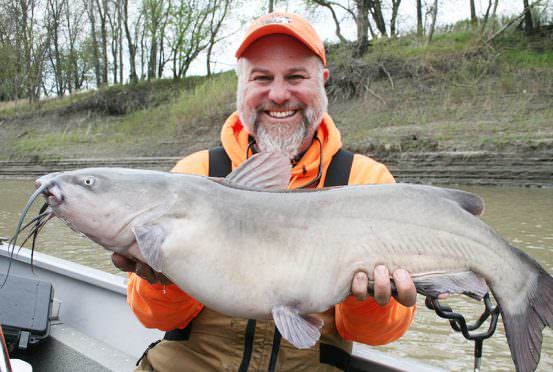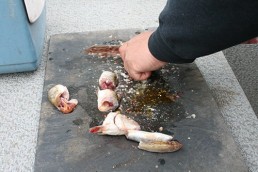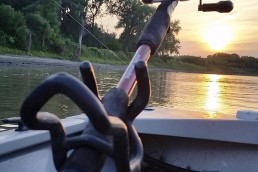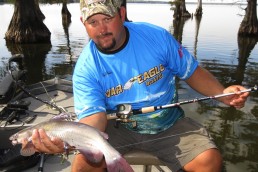Choosing the Right Bait when Fishing Catfish Corner
SHARE THIS POST
Around every corner is a catfish. It has happened to all of us, whether we fish for bass, walleyes or panfish. You work the corner of a pier, you troll around a corner of a drop-off or you cast to the corner of the riprap and it’s fish on! If it’s scrappy, but fighting weird and swimming in tight, crazy circles it’s a catfish.
It used to bother me; now I hope for them. Come the summer months, I fish for catfish almost exclusively, and there are three species to choose from: channels, flatheads and blues. And, each one offers fun and sport.

There aren’t only big-money catfish tournaments in the South, but they’re also all over the Midwest. Cabela’s sponsors the King Kat tourneys. Last year on a tournament on the Rock River, the winning team had a one-day, 95-pound total at weigh-in. Try and compare that to a bass or walleye tournament—those boys are catchin’ some fish.
While you can catfish with any old pole and reel, I like equipment geared toward what I am targeting. You’ll want a fairly stout rod from the boat. A 7 1/2-foot rod is about the right length with either medium or medium-heavy action. While a lot of anglers like catfish-specific spinning combos, I prefer a casting rod with a strong baitcasting reel. Use 30-pound-test mono or an 80-pound-test Power Pro. This line will allow you to pull out of snags.
When targeting catfish from shore, a long rod will allow you to make longer casts; a 10- or 12-footer is a great choice. High- vis. line or a jingle bell on the rod tip will help you notice hits and nudges by the catfish right away.
While there are many options for catfish, tried and true baits, like chicken liver, cut bait or dip bait, are my choices. Each requires a different-style hooking setup, but you can use the same slip-style sinker method. A flat river-style anchor is slid on the line first, followed by a 2-inch section of an aquarium hose. Then, tie on a heavy-duty swivel, a 2-foot, 25-pound-test leader and a hook to match the bait style.
Chicken liver as bait is great; it works equally well in rivers or lakes. You can find liver at any grocery store, but it will last longer if it is frozen first and you defrost it as you fish. A Mustad liver hook is the best way to hold the liver. It consists of a long shank double hook with a safety pin mechanism soldered to the shank. Slide the liver on the pin and snap it so it’s closed, make a cast and wait.
Are you enjoying this post?
You can be among the first to get the latest info on where to go, what to use and how to use it!
Catfish locations don’t have to be a spot for the lazy. Recently on a trip to the storied Red River, I fished with guide Brad Durrick. He stressed the importance of run-n-gun catfishing. Brad sets a timer and stays on a spot no longer than 15 minutes. Once your on a spot and when your bait hits the water, and if a catfish is around, it will investigate and then its sense of smell will take over as it hones in on the bait and gives it a “taste.”
When fishing a river, holes that are shallow or deep will hold fish. Water with fallen trees, current edges, eddies or below dams are top spots. You don’t want to fish in too heavy of a current, nor one that’s too weak. When fishing a lake or pond, points and inside edges are good. The depth varies for lakes, but as a rule I like to fish them in the fairly shallow areas.
Another bait of choice is dip bait. Dip bait, or stink bait as it is affectionately known, is derived from stinky fermented cheese. It has no shelf life, but stinks up everything it is adhered to. A dip worm is made of either plastic or elastic tubing. It will only adhere to the worm when the worm is dry, so you need to keep an old rag along to dry off your worm before baiting the hook again. Open the jar of the bait, find a stick to stir it up and then smash the dip worm in with the stick until there is a bunch of bait around it.
The final top bait is cut bait. Cut shad or suckers work a little better when they are fresh and cut to order. I’ll freeze the leftovers, but first I’ll add some fish oil scent and seal it in a Ziploc bag. Circle hooks are best used on cut bait; the beauty of the circle hook is that the cats will virtually hook themselves.
Rippin Lips makes some serious catfishing tackle for all sizes of fish. Their SuperCat Rods come in a variety of lengths and actions for both shore and boat anglers. These are strong rods, with soft, sensitive tips. SuperCat’s are made from a revolutionary new rod material, which has a mixture of graphite, S-Glass and E-Glass.
Walt Matan is the product developer for Rippin Lips, Custom Jigs & Spins and B-Fish-N Tackle. He lives in the heart of catfish country on the Mississippi River on the Illinois/Iowa border.
MWO
SHARE THIS POST
Did you enjoy this post?
You can be among the first to get the latest info on where to go, what to use and how to use it!
Walt Matan
Walt Matan has been a writer and television host for MidWest Outdoors for 30 years. An avid ice and open-water fisherman, he currently lives in the Quad Cities on the shores of the Mississippi River. He is the product developer and brand manager for Custom Jigs & Spins, B-Fish-N Tackle, and Rippin Lips Catfish Tackle. For more information visit customjigs.com.



